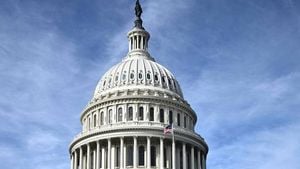Georgia’s farmers are facing a season of uncertainty as they navigate a complex landscape of rising costs, shifting federal policies, and delayed government funding. Over the past four or five years, input costs for farmers across the state have soared, but commodity prices haven’t kept pace, leaving many producers struggling to make ends meet. “Everything went up in the last four or five years, dramatically, and our commodity prices haven’t gone up to offset the losses,” said Davis, chairman of the Georgia Cotton Commission, according to reporting by the Atlanta Journal-Constitution.
While the Trump administration’s recent tax law has provided some relief through price protections and aid, many in the agricultural sector worry that these benefits might be undercut by other policy moves. The imposition of tariffs on imports by the Trump administration has triggered retaliatory levies from foreign ports, threatening the ability of U.S. farmers to export their goods abroad. Georgia U.S. Rep. Sanford Bishop, a Democrat from Albany, voiced concern about the impact of these tariffs on the state’s agricultural exports. “Tariffs will hurt some of our producers tremendously as they try to export some of the agricultural products that they produce in this country,” Bishop told the Atlanta Journal-Constitution. “And to address that, the administration will have to try to make those farmers whole in some way.”
The new spending law, while offering aid, has also brought cuts to the Supplemental Nutrition Assistance Program (SNAP), commonly known as food stamps. Bishop was critical of this development, arguing, “We should be able to protect our farmers, and we should be able to provide nutrition.” The cuts have sparked debate among lawmakers and advocacy groups, with critics pointing out that the law’s price protections don’t provide equal relief to all farmers. The National Farm Coalition, which advocates for small farmers, noted that independent growers—especially those cultivating fruits and vegetables—will see far less benefit than larger producers who received a bump in reference prices.
This disparity is evident in the distribution of aid across Georgia counties. Hall County, which has about 570 farmers, most of whom grow fruits, berries, and tree nuts, is projected to receive an additional $202,000 in aid over the next decade. That’s just a quarter of one percent of the aid going to Colquitt County, which has 430 farmers but a much larger share of the support, according to the Atlanta Journal-Constitution.
Ford Ramsey, an associate professor at the University of Georgia’s College of Agricultural and Environmental Sciences, explained that the impact of tariffs will vary by crop. “There could be concern that if a tariff is imposed on a country that imports a large quantity of a particular product, such as cotton, that country may place a retaliatory tariff on it,” Ramsey told the paper. He recalled the effects of the first trade war during the initial Trump administration, when similar dynamics played out.
For farmers like Davis, the current environment is fraught with anxiety. He admitted, “I lose sleep every night over this.” Within the last three years, Davis said he’s run at a loss, and he fears for the future of family farms if current trends continue. “You’ve got to stop the bleeding at some point in time,” he said, underscoring the urgent need for effective policy solutions.
Adding to the uncertainty, nearly $50 million in funding intended to help farmers experiment with new methods and address business challenges is currently sitting idle at the U.S. Department of Agriculture (USDA), as reported by POLITICO on September 8, 2025. The money, distributed through the Sustainable Agriculture Research and Education (SARE) program, typically supports more than 500 farmers and ranchers each year. These grants allow recipients to address issues like drought, pest outbreaks, and yield challenges, or to try out innovative techniques such as cover cropping.
The delay in distributing these funds has raised alarm, as the deadline to return unspent money to the U.S. Treasury is fast approaching. While the specific reasons for the holdup remain unclear, sources told POLITICO that the Office of Management and Budget (OMB) has exerted increasing control over the federal budget, contributing to the bottleneck. A USDA spokesperson declined to comment on the matter.
This funding freeze is part of a broader pattern of cuts and pauses in USDA spending under the Trump administration, which has recently slashed funds for renewable energy, local food programs, and agricultural research. These moves have drawn criticism from both sides of the political aisle, as the SARE program has enjoyed bipartisan support since its creation in 1988.
Meanwhile, the Trump administration is set to unveil its much-anticipated MAHA (Making America Healthy Again) strategy this week, following months of internal discussion. The MAHA Commission, created by executive order with a deadline of August 12, 2025, is expected to recommend sweeping changes to national health and nutrition policy. Industry groups and lawmakers are watching closely, with some, like the National Pork Producers Council, expressing concern that proposed definitions of "ultra-processed foods" could inadvertently penalize healthy agricultural products, including pork, by lumping them in with less nutritious options.
In the legislative arena, the House is scheduled to vote on reauthorizing the U.S. grain standards for another five years, a move that will ensure continued USDA inspection of major commodities like corn, wheat, soybeans, and sorghum. The bipartisan bill, co-sponsored by House Agriculture Chair G.T. Thompson (R-Pa.) and ranking member Angie Craig (D-Minn.), is expected to pass with minimal changes to existing law.
However, progress on the larger farm bill has stalled. Senate leaders now expect that any new farm bill will not be passed until the end of 2025, despite initial hopes of advancing the legislation in September. Senate Agriculture Chair John Boozman (R-Ark.) told POLITICO that lawmakers can “realistically” expect a farm bill at the end of the year, while Sen. John Hoeven (R-N.D.) added, “There’s no way it’s going to happen before Sept. 30,” citing a crowded legislative calendar.
Other issues at USDA have drawn fire from Democratic senators, including Amy Klobuchar (D-Minn.) and Peter Welch (D-Vt.), who criticized department leaders for failing to consult with union representatives on reorganization plans. In a letter signed by 18 senators and sent to Deputy Agriculture Secretary Stephen Vaden, the lawmakers expressed “serious concerns” about the lack of employee involvement in decisions that could affect working conditions and job locations.
Despite the policy turbulence, the need for effective support for America’s farmers has never been clearer. As Davis and his peers in Georgia continue to contend with rising costs, trade uncertainty, and delayed assistance, the future of family farming—and the broader agricultural sector—hangs in the balance, awaiting decisive action from Washington.




